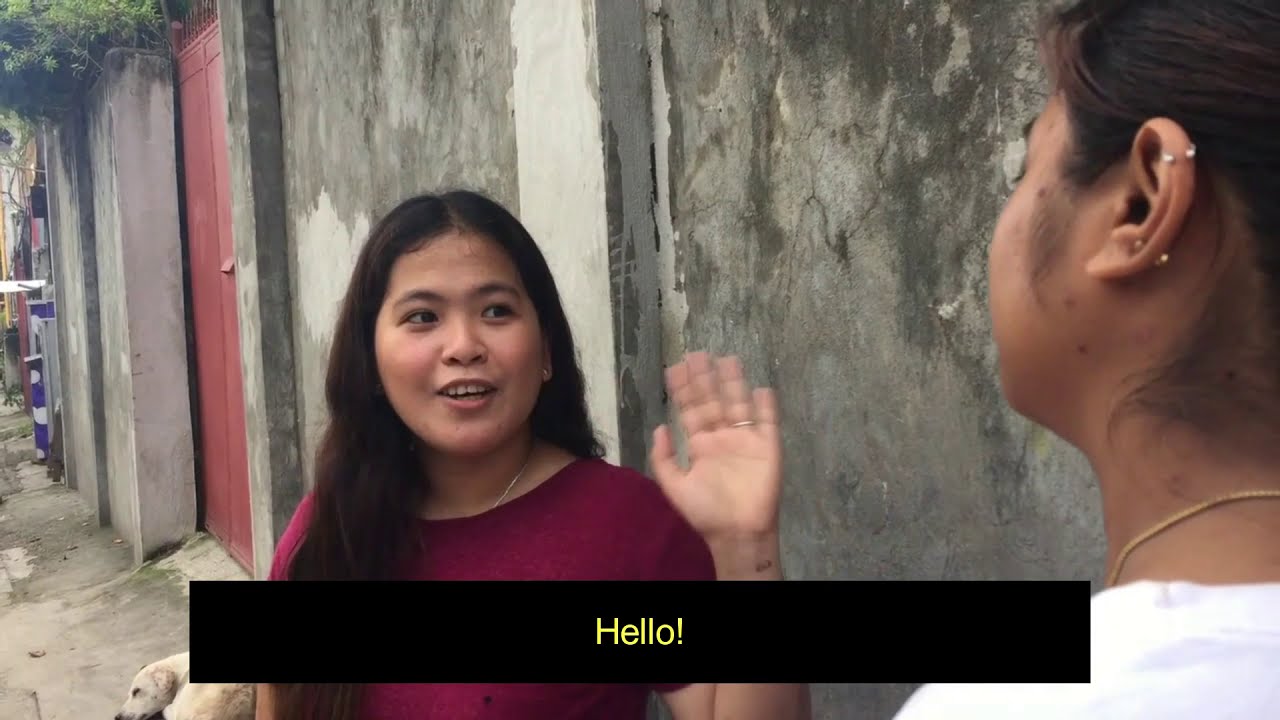Good day, friends! Today, we will learn how to introduce ourselves in Cebuano. It’s easy and fun! Let’s work together and learn some simple words and techniques to help you feel more comfortable using the language. Come on, let’s start learning!


*This learning material is designed with the assumption that you will be having lessons with Filipino wife, husband, boyfriend, girlfriend, friends, or language teachers.
Let’s review this video lesson!
In this lesson, you will;
1: Be able to know the greetings in Cebuano.
2: Learn how to greet people in Cebuano.
Vocabulary
Directions: Listen and repeat after your teacher.
1. Imong
- Meaning: Your (Possessive Pronoun)
- Part of Speech: Pronoun
- Usage: Refers to something belonging to the person being addressed.
- Example:
- Unsa ang imong pangandoy?
(What is your dream?) - Imong balay dako kaayo.
(Your house is very big.)
- Unsa ang imong pangandoy?
2. Pangalan
- Meaning: Name
- Part of Speech: Noun
- Usage: Used to refer to a person’s name or identity.
- Example:
- Unsa imong pangalan?
(What is your name?) - Ang iyang pangalan kay Maria.
(Her name is Maria.)
- Unsa imong pangalan?
3. Itawag / Tawga
- Meaning: To call / Call (imperative)
- Part of Speech: Verb
- Usage: Used to refer to calling someone, either literally or figuratively.
- Example:
- Itawag siya sa telepono.
(Call him/her on the phone.) - Tawga ang imong magulang.
(Call your elder sibling.)
- Itawag siya sa telepono.
4. Imoha
- Meaning: Yours / Belongs to you
- Part of Speech: Pronoun
- Usage: Used to indicate possession in a general sense.
- Example:
- Kini nga libro imoha ba?
(Is this book yours?) - Ang bag sa lamesa imoha.
(The bag on the table is yours.)
- Kini nga libro imoha ba?
5. Maayong panagkita nimo
- Meaning: Nice to meet you
- Part of Speech: Phrase
- Usage: A polite phrase used when meeting someone for the first time.
- Example:
- Maayong panagkita nimo, Juan!
(Nice to meet you, Juan!) - Maayong panagkita nimo, Sir.
(It’s nice to meet you, Sir.)
- Maayong panagkita nimo, Juan!
6. Kumusta ka karon?
- Meaning: How are you today?
- Part of Speech: Interrogative Phrase
- Usage: A polite way to ask about someone’s well-being, often at the start of a conversation.
- Example:
- Kumusta ka karon? Nalipay ka sa imong trabaho?
(How are you today? Are you happy with your work?) - Kumusta ka karon? Naa kay problema?
(How are you today? Do you have any problems?)
- Kumusta ka karon? Nalipay ka sa imong trabaho?
7. Maayo man
- Meaning: I’m fine / It’s fine
- Part of Speech: Phrase
- Usage: Used as a response to Kumusta ka? or to express general positivity.
- Example:
- Kumusta ka karon?
Maayo man, salamat.
(How are you today? I’m fine, thank you.) - Maayo man ang panahon karon.
(The weather is fine today.)
- Kumusta ka karon?
8. Bansag
- Meaning: Nickname / Title
- Part of Speech: Noun
- Usage: Refers to a nickname, alias, or title given to someone.
- Example:
- Ang akong bansag kay Toto.
(My nickname is Toto.) - Unsay bansag nimo?
(What is your nickname?)
- Ang akong bansag kay Toto.
Flashcards
Dialogue Practice
Directions: Read the following conversation with your teacher.
Dialogue 1
Joyce: Maayong Buntag
Leah: Maayong Buntag sad
Joyce: Ako si Joyce. Unsa imong pangalan?
Leah: Akong pangalan kay Leah.
Joyce: Unsa akong itawag sa imoha?
Leah: Palihug tawga lang ko og Yang.
Joyce: Sige. Maayong panagkita nimo.
Leah: Maayong panagkita pug nimo.
Joyce: Kumusta ka karon?
Leah: Maayo man. Ikaw, kumusta?
Joyce: Maayo pud, salamat.
Dialogue 2
Joyce: Hi!
Leah: Hello!
Joyce: Akong pangalan kay Joyce. Unsa imong pangalan?
Leah: Ako si Leah.
Joyce: Unsay bansag nimo?
Leah: Palihug tawga lang ko og Yang.
Joyce: Kumusta ka karon?
Leah: Okay ra. Ikaw?
Joyce: Okay ra.
Dialogue 1
Joyce: Good morning.
Leah: Good morning too.
Joyce: I’m Joyce. What’s your name?
Leah: My name is Leah.
Joyce: What should I call you?
Leah: Please call me Yang.
Joyce: Okay. Nice to meet you.
Leah: Nice to meet you too.
Joyce: How are you today?
Leah: I’m good. How about you?
Joyce: I’m good too, thank you.
Dialogue 2
Joyce: Hi!
Leah: Hello!
Joyce: My name is Joyce. What’s your name?
Leah: I’m Leah.
Joyce: What’s your nickname?
Leah: Please call me Yang.
Joyce: How are you today?
Leah: Not bad. How about you?
Joyce: I’m fine.
Comprehension Quiz
- How do we say ‘’Good morning” in Cebuano?
a. Maayong Hapon
b. Maayong Gabii
c. Maayong Udto
d. Maayong Buntag - Does the word ‘oi’ also a mean of greeting?
a. Yes
b. No
c. Maybe
d. None of the above - What does ‘nickname’ mean in Cebuano?
a. Pangalan
b. Panagkita
c. Kumusta
d. Bansag - How do you reply to the question ‘Kumusta ka karon?’?
a. Ako si Leah.
b. Maayo man
c. Maayong Buntag
d. Ikaw? - How do we say ‘What should I call you?’ in Cebuano?
a. Unsa imong pangalan?
b. Unsa akong itawag sa imoha?
c. Unsa imong gibuhat?
d. Unsa man kana?
Rearranging Sentence Quiz
Arrange the words to make sentences.
- imong / pangalan / Unsa/ ?
- akong / sa / Unsa / imoha / itawag / ?
- kay / pangalan / Joyce / Akong / .
- panagkita / nimo / Maayong
- ka / Kumusta / karon / ?
Fill-in-the-Blanks
Directions: Complete the sentence with the correct Cebuano word.
Quiz 1
Joyce: Maayong ________
Leah: Maayong ________ sad
Quiz 2
Joyce: Ako si Joyce. ________ imong pangalan?
Leah: Akong pangalan kay ________.
Quiz 3
Joyce: ________ akong itawag sa imoha?
Leah: Palihug tawga lang ko og ________.
Quiz 4
Joyce: Kumusta ka ________?
Leah: ________ man. Ikaw, kumusta?
Quiz 5
Joyce: Unsay bansag ________?
Leah: ________ tawga lang ko og Yang.
Phrase Matching Exercise
Directions: Match the numbers in the first column (Cebuano Phrase) with the corresponding letters in the shuffled second column (English Meaning).
| Cebuano Phrase | English Meaning |
|---|---|
| 1. Maayong Buntag | H. I’m good. How about you? |
| 2. Ako si Joyce. | J. Nice to meet you. |
| 3. Unsa imong pangalan? | F. Please call me Yang. |
| 4. Akong pangalan kay Leah. | A. Good morning |
| 5. Unsa akong itawag sa imoha? | I. I’m fine. |
| 6. Palihug tawga lang ko og Yang. | E. What should I call you? |
| 7. Kumusta ka karon? | C. What’s your name? |
| 8. Maayo man. Ikaw, kumusta? | G. How are you today? |
| 9. Okay ra. | B. I’m Joyce. |
| 10. Maayong panagkita nimo. | D. My name is Leah. |
Review
1:Three new words and phrases in the lesson.
2: Three difficult-to-pronounce words
Your teacher will choose and say each word. Please repeat the word with your teacher 3 times.
Answer
Comprehension Quiz
- How do we say “Good morning” in Cebuano?
Answer: d. Maayong Buntag - Does the word ‘oi’ also mean a greeting?
Answer: a. Yes - What does ‘nickname’ mean in Cebuano?
Answer: d. Bansag - How do you reply to the question ‘Kumusta ka karon?’?
Answer: b. Maayo man - How do we say ‘What should I call you?’ in Cebuano?
Answer: b. Unsa akong itawag sa imoha?
Rearranging Sentence Quiz
- imong / pangalan / Unsa / ?
Answer: Unsa imong pangalan? - akong / sa / Unsa / imoha / itawag / ?
Answer: Unsa akong itawag sa imoha? - kay / pangalan / Joyce / Akong / .
Answer: Akong pangalan kay Joyce. - panagkita / nimo / Maayong
Answer: Maayong panagkita nimo. - ka / Kumusta / karon / ?
Answer: Kumusta ka karon?
Fill-in-the-Blanks
Quiz 1
Joyce: Maayong Buntag
Leah: Maayong Buntag sad
Quiz 2
Joyce: Ako si Joyce. Unsa imong pangalan?
Leah: Akong pangalan kay Leah.
Quiz 3
Joyce: Unsa akong itawag sa imoha?
Leah: Palihug tawga lang ko og Yang.
Quiz 4
Joyce: Kumusta ka karon?
Leah: Maayo man. Ikaw, kumusta?
Quiz 5
Joyce: Unsay bansag nimo?
Leah: Palihug tawga lang ko og Yang.
Phrase Matching Exercise
| Cebuano Phrase | English Meaning |
|---|---|
| 1. Maayong Buntag | A. Good morning |
| 2. Ako si Joyce. | B. I’m Joyce. |
| 3. Unsa imong pangalan? | C. What’s your name? |
| 4. Akong pangalan kay Leah. | D. My name is Leah. |
| 5. Unsa akong itawag sa imoha? | E. What should I call you? |
| 6. Palihug tawga lang ko og Yang. | F. Please call me Yang. |
| 7. Kumusta ka karon? | G. How are you today? |
| 8. Maayo man. Ikaw, kumusta? | H. I’m good. How about you? |
| 9. Okay ra. | I. I’m fine. |
| 10. Maayong panagkita nimo. | J. Nice to meet you. |
This breakdown should help in understanding the grammar, context, and use of each sentence in the dialogue.
Part of speech breakdown for Dialogue 1
Joyce: Maayong Buntag
Grammatical Analysis
- Maayong (Adjective) – Means “good.”
- Buntag (Noun) – Means “morning.”
Usage
This phrase is equivalent to “Good morning” in English. It is used as a morning greeting when meeting someone.
Examples
- Maayong Buntag, Mama!
(Good morning, Mom!) - Maayong Buntag sa tanan!
(Good morning, everyone!)
Leah: Maayong Buntag sad
Grammatical Analysis
- Maayong (Adjective) – “Good.”
- Buntag (Noun) – “Morning.”
- Sad (Adverb) – Means “too” or “also.”
Usage
This is a response to someone’s morning greeting, meaning “Good morning to you too.”
Examples
- Maayong Buntag sad, Joyce.
(Good morning to you too, Joyce.) - Maayong Buntag sad nimo.
(Good morning to you too.)
3. Joyce: Ako si Joyce. Unsa imong pangalan?
Grammatical Analysis
- Ako (Pronoun) – Means “I.”
- si (Particle) – A marker for names.
- Joyce (Noun) – A name.
- Unsa (Interrogative) – Means “what.”
- imong (Pronoun) – Means “your.”
- pangalan (Noun) – Means “name.”
Usage
This is used in introductions and when meeting someone for the first time. It means, “I’m Joyce. What’s your name?”
Examples
- Ako si Maria. Unsa imong pangalan?
(I’m Maria. What’s your name?) - Ako si Pedro. Unsa imong pangalan?
(I’m Pedro. What’s your name?)
4. Leah: Akong pangalan kay Leah.
Grammatical Analysis
- Akong (Pronoun) – Means “my.”
- pangalan (Noun) – Means “name.”
- kay (Connector) – Means “is.”
- Leah (Noun) – A name.
Usage
This is used to state your name in response. It means “My name is Leah.”
Examples
- Akong pangalan kay Juan.
(My name is Juan.) - Akong pangalan kay Carla.
(My name is Carla.)
5. Joyce: Unsa akong itawag sa imoha?
Grammatical Analysis
- Unsa (Interrogative) – Means “what.”
- akong (Pronoun) – Means “my.”
- itawag (Verb) – Means “to call.”
- sa (Preposition) – Means “to.”
- imoha (Pronoun) – Means “you.”
Usage
This is used to ask someone what you should call them. It means “What should I call you?”
Examples
- Unsa akong itawag sa imoha, Juan?
(Juan, what should I call you?) - Unsa akong itawag sa imoha, Maria?
(Maria, what should I call you?)
6. Leah: Palihug tawga lang ko og Yang.
Grammatical Analysis
- Palihug (Adverb) – Means “please.”
- tawga (Verb) – Means “call.”
- lang (Adverb) – Means “just.”
- ko (Pronoun) – Means “me.”
- og (Preposition) – Means “as” or “by.”
- Yang (Noun) – A nickname.
Usage
This means “Please call me Yang.” It is used when sharing your nickname.
Examples
- Palihug tawga lang ko og Ana.
(Please call me Ana.) - Palihug tawga lang ko og Jun.
(Please call me Jun.)
7. Joyce: Sige. Maayong panagkita nimo.
Grammatical Analysis
- Sige (Interjection) – Means “okay” or “sure.”
- Maayong (Adjective) – Means “good.”
- panagkita (Noun) – Means “meeting.”
- nimo (Pronoun) – Means “you.”
Usage
This phrase means “Okay. Nice to meet you.” It is used to express pleasure in meeting someone for the first time.
Examples
- Sige. Maayong panagkita nimo, Ana.
(Okay. Nice to meet you, Ana.) - Sige. Maayong panagkita nimo, Pedro.
(Okay. Nice to meet you, Pedro.)
8. Leah: Maayong panagkita pud nimo.
Grammatical Analysis
- Maayong (Adjective) – Means “good.”
- panagkita (Noun) – Means “meeting.”
- pud (Adverb) – Means “too.”
- nimo (Pronoun) – Means “you.”
Usage
This means “Nice to meet you too.” It is a polite response to someone expressing pleasure at meeting you.
Examples
- Maayong panagkita pud nimo, Joyce.
(Nice to meet you too, Joyce.) - Maayong panagkita pud nimo, Ana.
(Nice to meet you too, Ana.)
9. Joyce: Kumusta ka karon?
Grammatical Analysis
- Kumusta (Verb) – Means “how are you.”
- ka (Pronoun) – Means “you.”
- karon (Adverb) – Means “today” or “now.”
Usage
This phrase means “How are you today?” It is used to ask about someone’s well-being.
Examples
- Kumusta ka karon, Ana?
(How are you today, Ana?) - Kumusta ka karon, Pedro?
(How are you today, Pedro?)
10. Leah: Maayo man. Ikaw, kumusta?
Grammatical Analysis
- Maayo (Adjective) – Means “good.”
- man (Adverb) – Means “is.”
- Ikaw (Pronoun) – Means “you.”
- kumusta (Verb) – Means “how are you.”
Usage
This means “I’m good. How about you?” It is used to reply to someone asking how you are and to return the question.
Examples
- Maayo man. Ikaw, kumusta?
(I’m good. How about you?) - Maayo man, Ana. Ikaw, kumusta?
(I’m good, Ana. How about you?)
11. Joyce: Maayo pud, salamat.
Grammatical Analysis
- Maayo (Adjective) – Means “good.”
- pud (Adverb) – Means “too.”
- salamat (Noun) – Means “thank you.”
Usage
This means “I’m good too, thank you.” It is used to reply politely to someone asking about your well-being.
Examples
- Maayo pud, salamat, Ana.
(I’m good too, thank you, Ana.) - Maayo pud, salamat, Pedro.
(I’m good too, thank you, Pedro.)
Part of speech breakdown for Dialogue 2
1. Joyce: Hi!
Grammatical Analysis
- Hi (Interjection) – A casual greeting.
Usage
This is a simple and informal way to greet someone, often used between friends or acquaintances.
Examples
- Hi, Maria!
(Hi, Maria!) - Hi, how are you?
(Hi, how are you?)
2. Leah: Hello!
Grammatical Analysis
- Hello (Interjection) – A formal or neutral greeting.
Usage
This is a more neutral greeting than “Hi,” and can be used in both formal and informal situations.
Examples
- Hello, Joyce!
(Hello, Joyce!) - Hello! Nice to meet you.
(Hello! Nice to meet you.)
3. Joyce: Akong pangalan kay Joyce. Unsa imong pangalan?
Grammatical Analysis
- Akong (Pronoun) – “My.”
- pangalan (Noun) – “Name.”
- kay (Connector) – “Is.”
- Joyce (Noun) – Name.
- Unsa (Interrogative) – “What.”
- imong (Pronoun) – “Your.”
- pangalan (Noun) – “Name.”
Usage
This is used in introductions. It means, “My name is Joyce. What’s your name?”
Examples
- Akong pangalan kay Maria. Unsa imong pangalan?
(My name is Maria. What’s your name?) - Akong pangalan kay Juan. Unsa imong pangalan?
(My name is Juan. What’s your name?)
4. Leah: Ako si Leah.
Grammatical Analysis
- Ako (Pronoun) – “I.”
- si (Particle) – Marker for names.
- Leah (Noun) – Name.
Usage
This is used to introduce oneself. It means, “I am Leah.”
Examples
- Ako si Pedro.
(I am Pedro.) - Ako si Ana.
(I am Ana.)
5. Joyce: Unsay bansag nimo?
Grammatical Analysis
- Unsay (Interrogative) – “What’s.”
- bansag (Noun) – “Nickname.”
- nimo (Pronoun) – “Your.”
Usage
This phrase is used to ask someone their nickname. It means, “What’s your nickname?”
Examples
- Unsay bansag nimo, Maria?
(What’s your nickname, Maria?) - Unsay bansag nimo, Pedro?
(What’s your nickname, Pedro?)
6. Leah: Palihug tawga lang ko og Yang.
Grammatical Analysis
- Palihug (Adverb) – “Please.”
- tawga (Verb) – “Call.”
- lang (Adverb) – “Just.”
- ko (Pronoun) – “Me.”
- og (Preposition) – “As.”
- Yang (Noun) – Nickname.
Usage
This phrase means, “Please just call me Yang.” It is used when giving a preferred name or nickname.
Examples
- Palihug tawga lang ko og Ana.
(Please just call me Ana.) - Palihug tawga lang ko og Jun.
(Please just call me Jun.)
7. Joyce: Kumusta ka karon?
Grammatical Analysis
- Kumusta (Verb) – “How are you.”
- ka (Pronoun) – “You.”
- karon (Adverb) – “Today” or “Now.”
Usage
This is used to ask someone how they are today. It means, “How are you today?”
Examples
- Kumusta ka karon, Ana?
(How are you today, Ana?) - Kumusta ka karon, Pedro?
(How are you today, Pedro?)
8. Leah: Okay ra. Ikaw?
Grammatical Analysis
- Okay (Adjective) – “Fine” or “Okay.”
- ra (Particle) – “Just.”
- Ikaw (Pronoun) – “You.”
Usage
This means, “I’m fine. How about you?” It is used to respond to someone asking how you are and to return the question.
Examples
9. Joyce: Okay ra.
Grammatical Analysis
- Okay (Adjective) – “Fine” or “Okay.”
- ra (Particle) – “Just.”
Usage
This is used to say, “I’m fine.” It is a simple response to someone asking how you are.
Examples
- Okay ra, salamat.
(I’m fine, thank you.) - Okay ra. Kumusta ka karon?
(I’m fine. How are you today?)
Feel free to leave a comment with any requests or questions you may have. We’re always happy to hear from you!



Comment